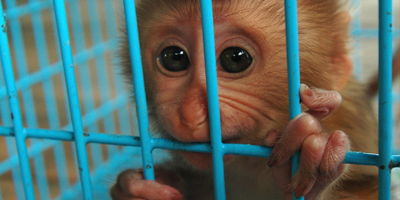Which Animals Are Used
Nonhuman Primates

Over 107,800 nonhuman primates used in U.S. laboratories in 2023, with macaques by far making up the majority. Macaques are also the most imported nonhuman primate for research. Other used and imported species include marmosets, squirrel monkeys, baboons, vervet monkeys, and owl monkeys. Many wild primate populations have been on the decline due to the enormous demand for these animals for research purposes. In fact, the International Union for Conservation of Nature lists long-tailed macaques as endangered on its Red List of Threatened Species, pointing to the overuse and capture of wild macaques for biomedical research.
Click here to read more about trends in the use and import of primates.
How Nonhuman Primates Are Used
In the European Union (EU), where detailed information is collected, a report published in 2023 noted that the majority of nonhuman primates are used to satisfy regulatory requirements for medicinal products for human use, such as drugs and vaccines, including studies for repeat dose toxicity. Such studies involve administration of a chemical intravenously or orally over an extended period of time, with gradually increasing toxic effects measured by repeated testing, such as blood and tissue sampling. In addition, the “routine production” for blood-based products is often overlooked, but consumes high numbers of animals, who endure a lifetime of “blood draws.”
In U.S. laboratories performing basic research, as in the EU, primates are often used for infectious disease research, such as HIV/AIDS, tuberculosis, hepatitis, and SARS-CoV-2; and are used as models to study heart disease, addiction, Parkinson’s disease, and Alzheimer’s disease, as well as for research into maternal deprivation, xenotransplantation (cross-species transplants), aging, gene therapy, neuroscience, reproductive biology, and bioterrorism agents. During experiments, they often live singly in cages with little stimulation and are usually killed when the testing ends.
Personal Lives of Nonhuman Primates
Primates have rich, emotional social lives, and they suffer greatly when isolated and confined, particularly when they need the comfort of a companion because they are going through difficult physical challenges. Because of that, single housing of primates is largely prohibited in the EU, but unfortunately, it is not unusual in the U.S. In the wild, nonhuman primates live in groups, with complex communication and familial social structures, especially maternal-child bonds. Those are nearly impossible to reproduce in captivity, because animals are routinely separated for human purposes. Furthermore, primates are not just capable of developing relationships; social interaction is critical for their psychological well-being. So important, in fact, that some primates will choose companionship over food.
The Animal Welfare Act does require that institutions have a plan to promote the “psychological well-being” of nonhuman primates, but it is questionable whether the interventions, such as providing dangling toys, are having a significant effect.
